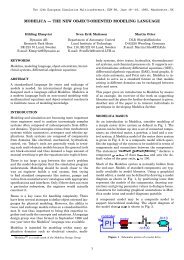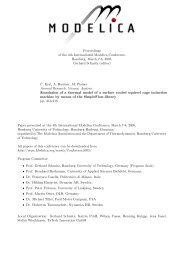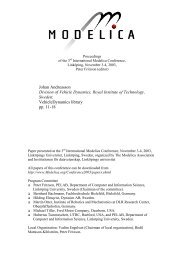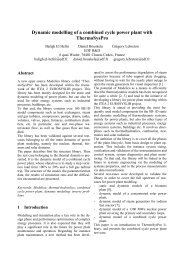Modelling of an adsorption chiller with Modelica
Modelling of an adsorption chiller with Modelica
Modelling of an adsorption chiller with Modelica
You also want an ePaper? Increase the reach of your titles
YUMPU automatically turns print PDFs into web optimized ePapers that Google loves.
Abstract<br />
<strong>Modelling</strong> <strong>of</strong> <strong>an</strong> <strong>adsorption</strong> <strong>chiller</strong> <strong>with</strong> <strong>Modelica</strong><br />
This paper describes the model <strong>of</strong> <strong>an</strong> <strong>adsorption</strong><br />
<strong>chiller</strong>. The model follows a component modeling<br />
approach based on the <strong>Modelica</strong> Media <strong>an</strong>d <strong>Modelica</strong><br />
Fluid Library. New models describe the phenomenon<br />
<strong>of</strong> condensing, evaporation <strong>an</strong>d <strong>adsorption</strong>.<br />
A new library has been created to describe the physical<br />
properties <strong>of</strong> <strong>adsorption</strong> materials. First simulations<br />
were performed <strong>an</strong>d are compared to measured<br />
data <strong>of</strong> <strong>an</strong> existing machine. The simulated curves<br />
show good accord<strong>an</strong>ce to measured data.<br />
Keywords: thermally driven <strong>chiller</strong>, <strong>adsorption</strong><br />
<strong>chiller</strong><br />
1 Introduction<br />
Facing a globally increasing cold dem<strong>an</strong>d to cover<br />
the need <strong>of</strong> comfort in hot areas <strong>an</strong>d at the same time<br />
facing the problem <strong>of</strong> global warming, the market for<br />
thermally driven <strong>chiller</strong>s is increasing. Thermally<br />
driven <strong>chiller</strong>s produce cold but are powered by heat<br />
instead <strong>of</strong> mech<strong>an</strong>ical work (electricity). Depending<br />
on the application, heat sources <strong>with</strong> temperatures<br />
above 70°C such as solar heat, waste heat or heat <strong>of</strong><br />
a cogeneration unit c<strong>an</strong> be used.<br />
Fig. 1: Thermally driven <strong>chiller</strong> (TDCs) pump heat<br />
from a low temperature heat source at TC to a middle<br />
temperature heat source at TM <strong>an</strong>d are powered by<br />
heat at a temperature level TH (TC
M. Schickt<strong>an</strong>z<br />
In the me<strong>an</strong>time the second adsorber (1) at the right<br />
side gets desorbed powered by energy <strong>of</strong> the hot water<br />
loop. This occurs at a higher pressure level by<br />
heating the adsorbent. The released water vapor<br />
passes the flap to the condenser where it condenses<br />
<strong>an</strong>d releases energy to the cooling loop. The condensate<br />
afterwards passes <strong>an</strong> exp<strong>an</strong>sion valve before<br />
reaching the evaporator.<br />
2 Structure <strong>of</strong> the <strong>adsorption</strong> <strong>chiller</strong><br />
model<br />
Fig. 3 shows the <strong>Modelica</strong> representation <strong>of</strong> the<br />
process described above. The four main components<br />
condenser, evaporator <strong>an</strong>d two adsorbers are separated<br />
by four flaps. All models are connected via the<br />
fluid port <strong>of</strong> the <strong>Modelica</strong> Fluid Library [1]. A causal<br />
connector represents the exp<strong>an</strong>sion valve between<br />
condenser <strong>an</strong>d evaporator.<br />
A...<br />
A...<br />
A...<br />
A...<br />
C...<br />
C...<br />
E_in<br />
E...<br />
Fig. 3: <strong>Modelica</strong> representation <strong>of</strong> the <strong>adsorption</strong><br />
<strong>chiller</strong> main components.<br />
2.1 Functional Component Models<br />
All main components used in the model have a similar<br />
design. Fig. 4 shows the graphical representation<br />
<strong>of</strong> the condenser.<br />
The model mainly uses components from the <strong>Modelica</strong><br />
Fluid Library. The ports at the top lead to the<br />
hydraulic connections (here cold water). The golden<br />
box in the middle represents a finned heat exch<strong>an</strong>ger<br />
which is described below. As a first approximation,<br />
the heat tr<strong>an</strong>sfer coefficient describing the condensation<br />
<strong>of</strong> water vapor at the heat exch<strong>an</strong>gers surface is<br />
assumed to be const<strong>an</strong>t. Therefore, a const<strong>an</strong>t ther-<br />
mal conductor taken from the <strong>Modelica</strong> St<strong>an</strong>dard<br />
Library connects the heat exch<strong>an</strong>ger to a condensing<br />
model. In the condensing model simple heat <strong>an</strong>d<br />
mass conservation equations are taken into account.<br />
Within this model, no mass <strong>an</strong>d energy storage takes<br />
place. All condensate is released to the water outlet<br />
connector which is a causal output connector <strong>an</strong>d<br />
was especially designed for this purpose. Opposed to<br />
the st<strong>an</strong>dard <strong>Modelica</strong> Fluid connector it only tr<strong>an</strong>smits<br />
flow variables (m_flow, H_flow) but no state<br />
variables (p, h), since the later ch<strong>an</strong>ge during the exp<strong>an</strong>sion<br />
process in the exp<strong>an</strong>sion valve.<br />
WaterOutlet<br />
hydrauli... hydrauli...<br />
SteamPin2<br />
k_value_Con...<br />
C...<br />
V<br />
G=k_cond...<br />
SteamPin1<br />
Fig. 4: Graphical <strong>Modelica</strong> representation <strong>of</strong> the condenser.<br />
The models for the evaporator <strong>an</strong>d the adsorber have<br />
the same structure as the condenser but the condensing<br />
model is replaced by <strong>an</strong> evaporation model <strong>an</strong>d<br />
<strong>an</strong> <strong>adsorption</strong> model, respectively.<br />
The evaporation model in the evaporator contains<br />
basically the same heat <strong>an</strong>d mass conservation equations<br />
as the condensing model, but additionally heat<br />
<strong>an</strong>d mass is stored to describe the refriger<strong>an</strong>t pool<br />
that covers the heat exch<strong>an</strong>ger. Moreover, the connector<br />
for the condensate is defined as input as a<br />
counterpart to the condenser.<br />
The <strong>adsorption</strong> model contains fundamental heat <strong>an</strong>d<br />
mass conservation equations <strong>with</strong> internal storage to<br />
describe the <strong>adsorption</strong> process. The load<br />
x = f ( p,<br />
T ) describes the amount <strong>of</strong> refriger<strong>an</strong>t<br />
that is adsorbed by the adsorbent<br />
mrefriger<strong>an</strong>t<br />
x =<br />
m<br />
adsorbent<br />
The <strong>Modelica</strong> Association 574 <strong>Modelica</strong> 2008, March 3 rd − 4 th , 2008
In equilibrium the load only depends on temperature<br />
<strong>an</strong>d pressure at the adsorbent surface. The specific<br />
<strong>adsorption</strong> enthalpy had<br />
as well as the equilibrium<br />
relation x = f ( p,<br />
T ) are defined in the <strong>adsorption</strong><br />
material package described below. However, the<br />
speed <strong>of</strong> <strong>adsorption</strong> is described as a simple linear<br />
relation between driving pressure <strong>an</strong>d mass flow<br />
m& = β ( psat<br />
− p)<br />
where psat<br />
is the saturation pressure for the refriger<strong>an</strong>t<br />
in the adsorbent, p is the vapor pressure in the<br />
vessel <strong>an</strong>d m& is the mass flow <strong>of</strong> refriger<strong>an</strong>t into or<br />
out <strong>of</strong> the adsorbent. β is <strong>an</strong> effective diffusion coefficient<br />
that describes the kinetics <strong>an</strong>d so for is a fit<br />
parameter [2].<br />
2.2 Finned Heat Exch<strong>an</strong>ger Model<br />
Fig. 5 shows a graphical representation <strong>of</strong> a finned<br />
heat exch<strong>an</strong>ger model. It is a simple model consisting<br />
<strong>of</strong> different heat capacities for fins <strong>an</strong>d tubes <strong>an</strong>d<br />
a const<strong>an</strong>t heat tr<strong>an</strong>sfer coefficient model that represents<br />
the heat tr<strong>an</strong>sfer from the hydraulic medium in<br />
the pipe to the pipe’s wall. The pipe model from the<br />
<strong>Modelica</strong> Fluid Library is applied.<br />
hydrauli... hydrauli...<br />
CapacityFins<br />
cp_Fi...<br />
HTC_Medium...<br />
heatPort<br />
pipe<br />
G=k_Tube...<br />
CapacityTu...<br />
cp_T...<br />
Fig. 5: <strong>Modelica</strong> representation <strong>of</strong> a simple finned heat<br />
exch<strong>an</strong>ger.<br />
2.3 Adsorption <strong>chiller</strong> piping model<br />
Fig. 6 shows a graphical representation <strong>of</strong> the <strong>adsorption</strong><br />
<strong>chiller</strong> piping. The purpose <strong>of</strong> the piping is<br />
to distribute the flow <strong>of</strong> the three loops for hot water,<br />
cooling water <strong>an</strong>d chilled water to the four main<br />
components.<br />
The connections to the hot water, cooling water <strong>an</strong>d<br />
chilled water loops are shown on the left side. The<br />
connections to the four vessels from Fig. 3 are on<br />
the right side. The single valve in the lower right<br />
controls the distribution <strong>of</strong> the cooling water between<br />
condenser <strong>an</strong>d cooled adsorber. From a hydraulic<br />
point <strong>of</strong> view both vessels are arr<strong>an</strong>ged in<br />
parallel.<br />
H...<br />
H...<br />
M...<br />
M...<br />
C...<br />
C...<br />
<strong>Modelling</strong> <strong>of</strong> <strong>an</strong> Adsorption Chiller <strong>with</strong> <strong>Modelica</strong><br />
SignalVal...<br />
SignalVal...<br />
Temp_A1_out<br />
const<br />
k=0....<br />
T<br />
Temp_A2_out<br />
Fig. 6: <strong>Modelica</strong> representation <strong>of</strong> the piping <strong>of</strong> the<br />
<strong>adsorption</strong> <strong>chiller</strong>.<br />
The two three-way-valves in the upper left <strong>of</strong> Fig. 6<br />
control the forward flow <strong>of</strong> hot water <strong>an</strong>d cooling<br />
water. Either the one or the other adsorber is connected<br />
to the hot water loop <strong>an</strong>d cold water loop,<br />
respectively. Similarly, the two three-way-valves in<br />
the middle control the reverse flow. An external controller<br />
connected via the control connector at the bottom<br />
controls the valves. In order to improve the efficiency<br />
<strong>of</strong> the <strong>chiller</strong> the reverse flow valves are<br />
switched according to the temperatures in the reverse<br />
flow <strong>of</strong> the adsorbers. The warmer outlet flow is<br />
connected to the hot water <strong>an</strong>d the colder outlet flow<br />
to the cooling water. Therefore, temperatures at the<br />
adsorber outlets are delivered to the controller.<br />
Switching <strong>of</strong> the valves in reverse flow occurs at a<br />
later time th<strong>an</strong> switching <strong>of</strong> the valves in forward<br />
flow.<br />
3 Adsorption Material Properties<br />
At Fraunh<strong>of</strong>er ISE different <strong>adsorption</strong> materials are<br />
measure <strong>an</strong>d characterized. The material package in<br />
the adsorber model is therefore defined as replaceable<br />
<strong>an</strong>d simulation c<strong>an</strong> be performed <strong>with</strong> different<br />
materials.<br />
The <strong>Modelica</strong> Association 575 <strong>Modelica</strong> 2008, March 3 rd − 4 th , 2008<br />
Temp_A1<br />
T<br />
A...<br />
A...<br />
A...<br />
A...<br />
C...<br />
C...<br />
E_in<br />
E...<br />
Temp_A2
M. Schickt<strong>an</strong>z<br />
3.1 Description <strong>of</strong> the <strong>adsorption</strong> physics<br />
According to Dubinin’s theory [4] the physical equilibrium<br />
between temperature, pressure <strong>an</strong>d load in<br />
the adsorber c<strong>an</strong> be described by knowing only one<br />
function<br />
W = f (A)<br />
3<br />
in which [ W ] = m<br />
kg is the <strong>adsorption</strong> volume onto<br />
the adsorbent surface that describes how much vapor<br />
c<strong>an</strong> be adsorbed. Therefore, it is proportional to the<br />
load<br />
x = ρ ⋅W<br />
where ρ is the density <strong>of</strong> the refriger<strong>an</strong>t in the liquid<br />
adsorbed state. The <strong>adsorption</strong> potential<br />
[ A ] = J<br />
kg describes the conditions <strong>of</strong> pressure <strong>an</strong>d<br />
temperature charactering <strong>adsorption</strong> process <strong>an</strong>d is<br />
defined as<br />
prefriger<strong>an</strong>t<br />
A = R ⋅ T ⋅ ln<br />
p<br />
<strong>with</strong> specific gas const<strong>an</strong>t R , saturation pressure <strong>of</strong><br />
the pure refriger<strong>an</strong>t prefriger<strong>an</strong>t<br />
<strong>an</strong>d saturation pressure<br />
p <strong>of</strong> the refriger<strong>an</strong>t in the adsorbed state. Also<br />
the <strong>adsorption</strong> enthalpy had<br />
is derived from the<br />
characteristic material equation:<br />
⎛ ∂A<br />
⎞<br />
had = hv<br />
+ A − T ⋅α<br />
⎜ ⎟<br />
⎝ ∂ lnW<br />
⎠<br />
Here hv<br />
is the specific evaporation enthalpy <strong>of</strong> the<br />
refriger<strong>an</strong>t <strong>an</strong>d α is the linear thermal exp<strong>an</strong>sion<br />
coefficient <strong>of</strong> refriger<strong>an</strong>t in the adsorbed state.<br />
3.2 Implementation <strong>of</strong> <strong>adsorption</strong> data in <strong>Modelica</strong><br />
The implementation <strong>of</strong> the <strong>adsorption</strong> material properties<br />
in <strong>Modelica</strong> follows Dubinin’s theory to describe<br />
all parameters <strong>with</strong> the W = f (A)<br />
relation. In<br />
practice, for the specific <strong>adsorption</strong> enthalpy also the<br />
derivative ∂ W is needed since <strong>Modelica</strong> c<strong>an</strong>not<br />
∂A<br />
perform this tr<strong>an</strong>sformation. Therefore, three functions<br />
are needed to describe the properties <strong>of</strong> a material:<br />
The first function describes the relation between W<br />
<strong>an</strong>d A (which may contain piecewise-defined functions),<br />
the second function gives the according derivative<br />
<strong>an</strong>d the third function contains the needed<br />
coefficients. The first two functions therefore are<br />
extended by the coefficient function.<br />
T<br />
Each material package is then extended by a partial<br />
base class package. In this partial package all physical<br />
<strong>adsorption</strong> properties as described above are calculated.<br />
So far, all implemented <strong>adsorption</strong> materials work<br />
<strong>with</strong> water as refriger<strong>an</strong>t but in principle it is possible<br />
to extend the package to the physical properties<br />
<strong>of</strong> other <strong>adsorption</strong> pairs like meth<strong>an</strong>ol/activated carbon.<br />
4 Preliminary results <strong>an</strong>d discussion<br />
Simulations <strong>with</strong> real measured data as input have<br />
been performed in order to compare the model <strong>with</strong> a<br />
real machine. As working water according to the<br />
IAPWS-formulation from the <strong>Modelica</strong> Media Library<br />
<strong>an</strong>d pair silica gel from the <strong>adsorption</strong> materials<br />
package are used. Measurement data come from<br />
the SorTech SKA PT 402 <strong>chiller</strong>. Data for temperature<br />
<strong>an</strong>d mass flow at the inlets <strong>of</strong> the <strong>adsorption</strong> machine<br />
are given as inputs for the simulation from the<br />
measurement. Weight <strong>of</strong> adsorbent <strong>an</strong>d heat capacities<br />
are given as parameters. Moreover, switching<br />
times for forward valves in the <strong>adsorption</strong> <strong>chiller</strong><br />
piping are set m<strong>an</strong>ually, whereas reverse flow valves<br />
are switched by the controller as described above.<br />
Fig. 7 compares measured data <strong>with</strong> the simulated<br />
results. It shows the measured temperatures at the<br />
inlet <strong>an</strong>d outlet <strong>of</strong> the hot water, cooling water <strong>an</strong>d<br />
chilled water loops versus time. Moreover, simulated<br />
results at the outlets are shown.<br />
Fig. 7: Comparison between measured <strong>an</strong>d simulated<br />
data. Temp_HW_in.T, Temp_MW_in.T <strong>an</strong>d<br />
Temp_E_in.T are input data for the inlets <strong>of</strong> the <strong>adsorption</strong><br />
<strong>chiller</strong>. Temp_HW_out.T, Temp_MW_out.T<br />
<strong>an</strong>d Temp_E_out.T are simulated temperature values<br />
at the <strong>chiller</strong>’s outlets. HW_out_Measured.y,<br />
MW_out_Measured.y <strong>an</strong>d CW_out_Measured.y are<br />
measured outlet temperatures.<br />
A half cycle needs approximately about 500s. After<br />
this time <strong>adsorption</strong> or desorption, respectively, stops<br />
<strong>an</strong>d the valves in the piping model are switched to<br />
ch<strong>an</strong>ge operation mode. Therefore, a complete ad-<br />
The <strong>Modelica</strong> Association 576 <strong>Modelica</strong> 2008, March 3 rd − 4 th , 2008
sorption/desorption cycle needs about 1000s. The<br />
peaks especially in the hot <strong>an</strong>d cooling water loop<br />
are caused by this switching process.<br />
The simulated curves show good accord<strong>an</strong>ce to the<br />
measured data. After the switching process the simulated<br />
output temperature from the hot water loop<br />
(Temp_HW_out.T) <strong>an</strong>d measured data<br />
(HW_out_measured.y) start from a similar temperature<br />
<strong>an</strong>d converge against the same final desorption<br />
temperature.<br />
The same is true for the simulated <strong>an</strong>d measured values<br />
(Temp_MW_out.T) <strong>an</strong>d (MW_out_measured.y),<br />
respectively, in the cooling water loop.<br />
In both loops the simulated temperature differences<br />
after the switching process are smaller th<strong>an</strong> the<br />
measured values. This might indicate that the switching<br />
in the reverse flow valves <strong>of</strong> the SKA PT 402<br />
happens to soon.<br />
Inlet temperatures actually were supposed to be const<strong>an</strong>t<br />
temperatures but the test bench for the <strong>chiller</strong><br />
was not able to h<strong>an</strong>dle the high power requirement<br />
which resulted in oscillating inlet temperatures. For<br />
example the middle temperature level<br />
Temp_MW_in.T shows a double overshoot in the<br />
time interval 5800s-5900s. The model c<strong>an</strong> h<strong>an</strong>dle<br />
this fluctuation. At the outlet Temp_MW_out.T <strong>an</strong>d<br />
MW_out_measured.y both show a reaction to the<br />
fluctuation. But since the model does not include the<br />
length <strong>of</strong> the pipes between adsorber <strong>an</strong>d thermometer<br />
the simulated reaction happens before the real<br />
measured events.<br />
5 Conclusion<br />
A simulation model for <strong>an</strong> <strong>adsorption</strong> <strong>chiller</strong> on a<br />
component approach has been implemented in <strong>Modelica</strong>.<br />
Even though it consists <strong>of</strong> simple equations for<br />
heat <strong>an</strong>d mass tr<strong>an</strong>sfer it already shows good accord<strong>an</strong>ce<br />
to measured data. It demonstrates the principle<br />
functions <strong>of</strong> the <strong>adsorption</strong> <strong>chiller</strong> <strong>an</strong>d shows reaction<br />
to dynamic ch<strong>an</strong>ges.<br />
Moreover a package for different <strong>adsorption</strong> materials<br />
has been designed according to Dubinin's Theory.<br />
New measurements will also contain pressure data in<br />
the <strong>adsorption</strong> machine, <strong>with</strong> this data it will be possible<br />
to calibrate the free parameters in the model<br />
which are currently only first approximations.<br />
<strong>Modelling</strong> <strong>of</strong> <strong>an</strong> Adsorption Chiller <strong>with</strong> <strong>Modelica</strong><br />
Acknowledgment<br />
I would like to th<strong>an</strong>k SorTech AG for appropriating<br />
measured data.<br />
References<br />
[1] Casella F., Otter M., Proelss K., Richter C.,<br />
Tummescheit H., The <strong>Modelica</strong> Fluid <strong>an</strong>d<br />
Media library for modeling <strong>of</strong> incompressible<br />
<strong>an</strong>d compressible thermo-fluid pipe networks.<br />
<strong>Modelica</strong> Conference 2006<br />
[2] Núñez, T. Charakterisiserung und Bewertung<br />
von Adsorbentien für Wärmetr<strong>an</strong>sformations<strong>an</strong>wendungen.<br />
Freiburg im Breisgau,<br />
Germ<strong>an</strong>y: PhD thesis, Department for physics,<br />
Albert-Ludwigs-Universität, 2001.<br />
[3] Henning H-M, Solar cooling. Presentation<br />
ISES Beijing, China 2007.<br />
[4] Dubinin M. Physical Adsorption <strong>of</strong> Gases<br />
<strong>an</strong>d Vapors in Micropores, volume 9, pages<br />
1-70. Academic Press, 1975.<br />
The <strong>Modelica</strong> Association 577 <strong>Modelica</strong> 2008, March 3 rd − 4 th , 2008

















